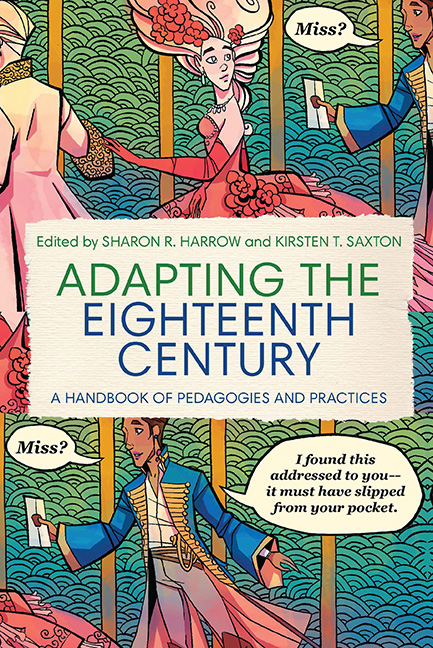Book contents
- Frontmatter
- Dedication
- Contents
- Acknowledgments
- Introduction
- 1 “Je suis Voltaire,” or, Appropriating the Philosophe in the Social Media Age
- 2 “Who Lives, Who Dies, Who Tells Your Story?”: The Uses of Hamilton in Special Collections Pedagogy and Public Engagement
- 3 Performing Frankenstein in the South: Sex, Race, and Science across the Disciplines
- 4 French Fairy Tales and Adaptations in the Twenty-First-Century Classroom
- 5 Select Trials at the Sessions-House in the Old-Bailey (1742) and Mark Ravenhill’s Mother Clap’s Molly House (2001)
- 6 Teaching with The Pilgrim’s Progress Video Game
- 7 Eliza Haywood’s “Bad Habits”: Teaching Adaptations of Fantomina: or, Love in a Maze and The Distress’d Orphan; or, Love in a Madhouse
- 8 Teaching Eighteenth-Century Literature through Eighteenth- Century Adaptations: Adaptive Structures
- 9 “A Private Had Been Flogged”: Adaptation and the “Invisible World” of Jane Austen
- 10 Fifty Shades of Pamela in the Undergraduate Classroom
- 11 Teaching the Austen-Monster-Mashup: Sense and Sensibility and Sea Monsters
- 12 Learning to Adapt: Teaching Pride and Prejudice and Its Adaptations in General Education Courses
- 13 Race and Romance: Adapting Free Women of Color in the Long Eighteenth Century
- 14 The Crusoeiana: Material Crusoe
- 15 Adaptation in Strange Places: Terrence Malick’s To the Wonder and the Narrative Effect and Form of Samuel Richardson’s Pamela
- 16 Adapting the Tombeaux des Princes: A Study in Media Variations
- 17 Experiential Pedagogy to Join the Thread of Conversation with Paul et Virginie
- 18 “Lookin’ for a Mind at Work”: Hamilton, Adaptation, and Enlightenment Ideals for the Core Curriculum
- Notes on the Contributors
- Index
14 - The Crusoeiana: Material Crusoe
Published online by Cambridge University Press: 26 April 2020
- Frontmatter
- Dedication
- Contents
- Acknowledgments
- Introduction
- 1 “Je suis Voltaire,” or, Appropriating the Philosophe in the Social Media Age
- 2 “Who Lives, Who Dies, Who Tells Your Story?”: The Uses of Hamilton in Special Collections Pedagogy and Public Engagement
- 3 Performing Frankenstein in the South: Sex, Race, and Science across the Disciplines
- 4 French Fairy Tales and Adaptations in the Twenty-First-Century Classroom
- 5 Select Trials at the Sessions-House in the Old-Bailey (1742) and Mark Ravenhill’s Mother Clap’s Molly House (2001)
- 6 Teaching with The Pilgrim’s Progress Video Game
- 7 Eliza Haywood’s “Bad Habits”: Teaching Adaptations of Fantomina: or, Love in a Maze and The Distress’d Orphan; or, Love in a Madhouse
- 8 Teaching Eighteenth-Century Literature through Eighteenth- Century Adaptations: Adaptive Structures
- 9 “A Private Had Been Flogged”: Adaptation and the “Invisible World” of Jane Austen
- 10 Fifty Shades of Pamela in the Undergraduate Classroom
- 11 Teaching the Austen-Monster-Mashup: Sense and Sensibility and Sea Monsters
- 12 Learning to Adapt: Teaching Pride and Prejudice and Its Adaptations in General Education Courses
- 13 Race and Romance: Adapting Free Women of Color in the Long Eighteenth Century
- 14 The Crusoeiana: Material Crusoe
- 15 Adaptation in Strange Places: Terrence Malick’s To the Wonder and the Narrative Effect and Form of Samuel Richardson’s Pamela
- 16 Adapting the Tombeaux des Princes: A Study in Media Variations
- 17 Experiential Pedagogy to Join the Thread of Conversation with Paul et Virginie
- 18 “Lookin’ for a Mind at Work”: Hamilton, Adaptation, and Enlightenment Ideals for the Core Curriculum
- Notes on the Contributors
- Index
Summary
Few novels have been adapted more widely than Robinson Crusoe has been over the past three hundred years. Every adaptation is implicitly or explicitly an interpretation, itself ripe for interpretation, and each can tell us something, therefore, about the novel and its place in both the cultural imagination and the physical world. I focus here on “Illustrations and the Cultural Imagination,” “Editions and Variations,” “Crusoe for Children: Playing and Making,” “For the Home,” and “Advertisements”; with the help of material culture, Daniel Defoe's canonical, widely dissected fi rst novel can be freshly and uniquely approached by students. My related writing assignments, which can run short or long, are versions of the same assignment: all ask students, “How do these material artifacts represent, revise, engage, respond to, make use of, or otherwise interpret Robinson Crusoe?” Th ere is no dearth of easily accessed digital images, from illustrations (and images that make use of frequently illustrated scenes), to editions (and abridgements, chapbooks), to paper dolls and other toys, to collectible porcelain tchotchkes, to advertisements for underwear or salad dressing, and all of them are interpretable interpretations. I have used the following assignments to approach Crusoe in survey courses such as Restoration and Eighteenth-Century Literature and the Eighteenth-Century British Novel and Narrative, and in seminars on the eighteenth-century Robinsonade micro-genre (the micro-genre of being stranded on a deserted island) and on the transhistorical Robinsonade from antecedents to modern heirs, across different literary forms and other media. I ask students to select one of the assignments, and to write a short paper that may or may not lead to a longer paper later on. My methodology with Crusoeiana is adaptable for use with any work (or any author) that has an extensive history of material adaptation and interpretation; thus, in addition to describing how students can find Crusoeiana, write about Crusoeiana, and thereby understand Crusoe itself from a rich and original perspective, this chapter also implies a broader model of adaptive pedagogy.
Illustrations and the Cultural Imagination
Not surprisingly, the easiest way for students to find visual images gener- ally is by searching online, using any search engine's “Images” tab to search for “Crusoe,” or, perhaps, “Crusoe” and “Friday,” “Crusoe” and “parrot.” (Examples of each image and object discussed in this chapter can be seen on the internet.)
- Type
- Chapter
- Information
- Adapting the Eighteenth CenturyA Handbook of Pedagogies and Practices, pp. 213 - 233Publisher: Boydell & BrewerPrint publication year: 2020

